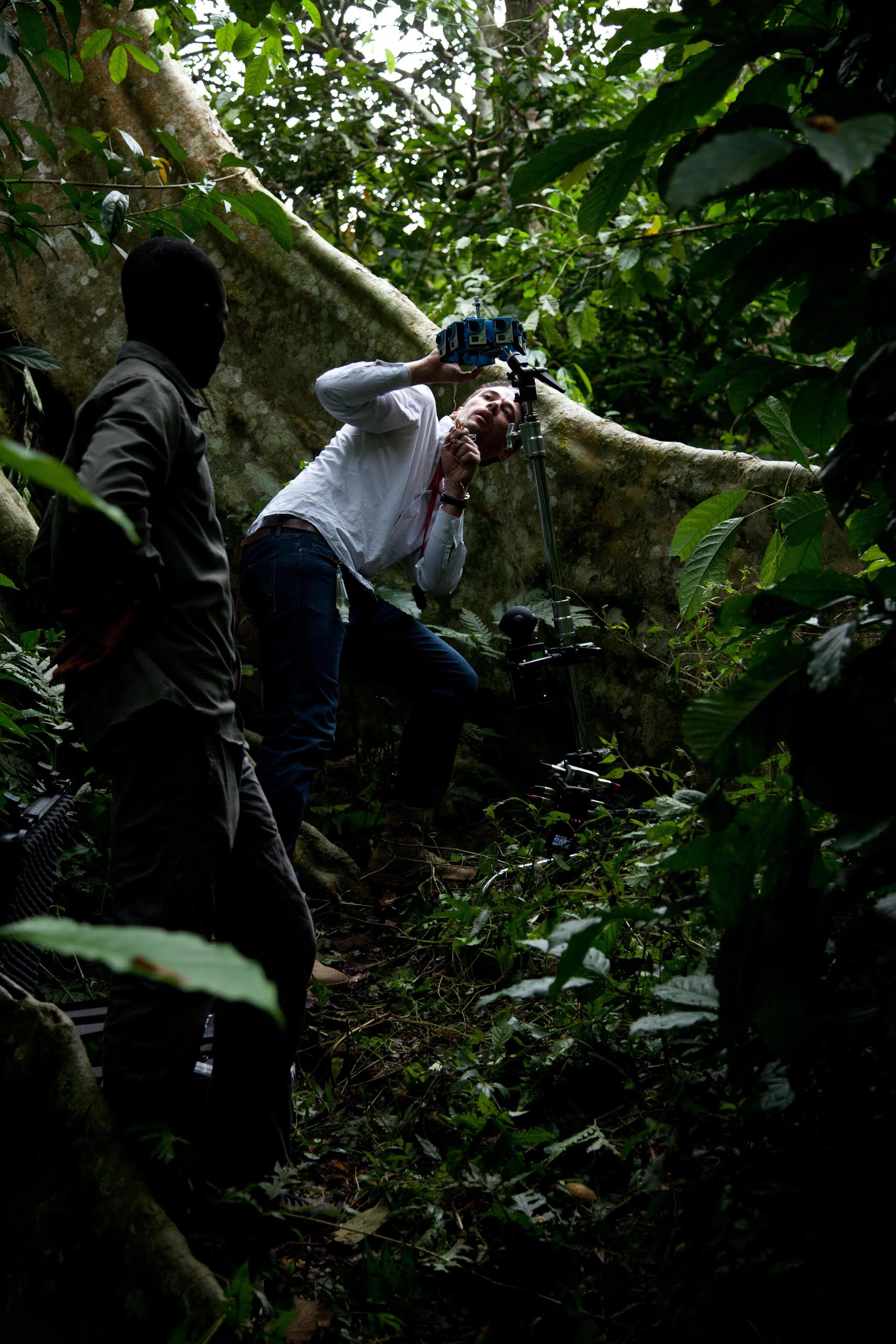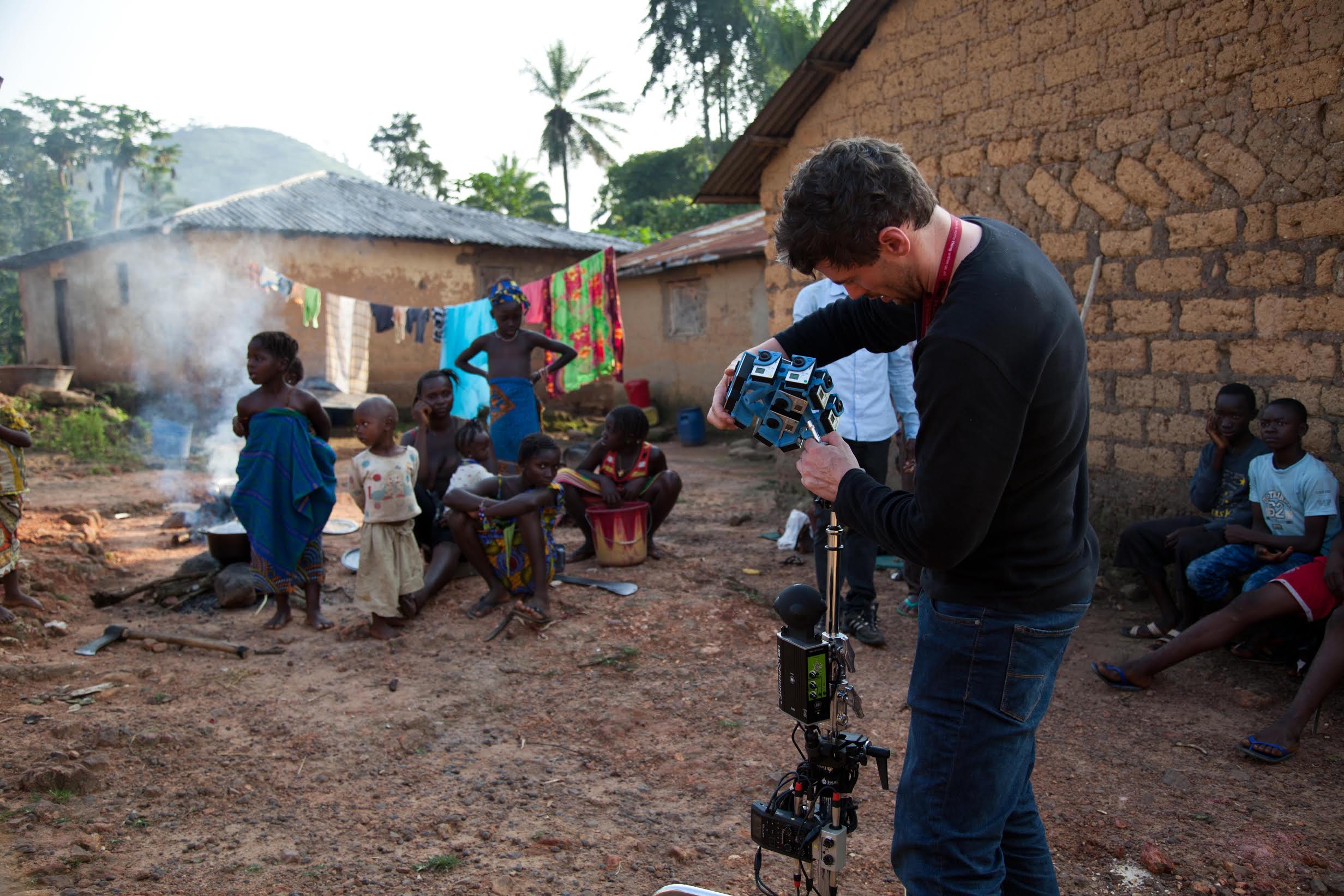In the Field
Dan Edge worked as part of a two-person team, shooting 360-degree, stereoscopic video of three scenes in West Africa; two scenes were in a region around 17 miles northwest of the intersecting borders of Guinea, Sierra Leone, and Liberia. The third location was a field clinic in Macenta, 60 miles farther east in Guinea. Throughout this field shoot, Edge and his team primarily focused on collecting material for his traditional Frontline TV documentary.
His first location was at the foot of a tall kola nut tree in the jungle where a 2-year-old named Emile is thought to have come in contact with bats. This tree is the site where some scientists believe the boy contracted the Ebola virus, which killed him in December of 2013. The tree was quite close to Edge’s next location: the village of Meliandou where Emile lived, and the virus spread to his sister, mother, grandmother, and the rest of the victims who then passed it on to more than 27,000 people in neighboring Guinea, Sierra Leone, and Liberia.
At the kola nut tree, Edge filmed in two short sessions: the first batch of video was just two minutes, interrupted by the onset of a thunderstorm. The second kola nut tree shoot was around eight minutes long.
These shoots were the first time Edge used the prototype camera in the field. To understand the complexity of the filming process, it’s useful to realize that the camera rig was an improvised, immature combination of technologies. It used 12 GoPro cameras held in stereo pairs by a 3D-printed frame. GoPro cameras, while widely used in professional settings, lack certain “high-end” features. They have inconsistencies in their lenses, provide only limited control over color and light levels, and don’t have automatic synchronization or calibration features.

To produce stitchable footage, the field crew needed to provide a visual reference for calibration in post-production. Secret Location’s solution was to tie a piece of string to the top of the camera mount and hold it to the chest of a crewmember, who then walked in a circle around the camera. The string kept the crewmember at a consistent distance from the camera, helping the post-production team identify which pixels from one camera should line up with the next.
Edge’s first batch of footage collected at the kola nut tree suffered from a combination of nonprofessional equipment and difficult, highly variable lighting conditions. The 12 GoPros’ auto-exposure software fluctuated wildly, which made stitching the video files together very laborious.
The director’s experience in Meliandou was better. He described it as a “typical Guinean jungle village scene—kids playing, women cooking, men sitting.”
 In the video capture, viewers can see children walking past, locals
fidgeting, and smoke drifting upwards.
In the video capture, viewers can see children walking past, locals
fidgeting, and smoke drifting upwards.
Sixty miles east, Edge also filmed at a French Red Cross Ebola clinic in Macenta, Guinea. He filmed for around 30 minutes, letting action unfold around the camera. Two figures in hazmat suits exchange black disposal bags; a figure walks a wheelbarrow past, and there are glimpses of patients between tent edges.
Overall, Edge reported a difficult experience:
It was a huge challenge to transport, maintain, and operate the equipment in the field without a technician or at least another pair of hands on the team. There was very little access to electricity in the jungle—so charging 12 cameras and a zoom, et cetera, was not straightforward. It was hot and difficult work. The odd-looking camera engendered suspicion in locals; some assumed it was a malevolent machine that would make villagers sick. I have a feeling exposure may be a real problem. Having looked through the files it seems to me that the sky is exposed differently in different shots, which I think may make stitching problematic. . . . I wouldn’t be that keen to shoot in the jungle again without a specific person whose job it is to manage the gear!
Crucially, Edge’s approach to shooting the 360-degree footage was to place the camera and let any action unfold around him. In his words, “Each scene places us at an important location/moment in the history of the outbreak—places most of us would never normally go to.” He didn’t shoot interviews or high-action scenes in 3D. This produced a challenge later in the project, which is discussed in the findings section of this report.